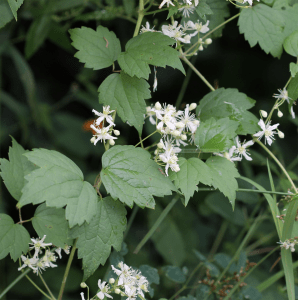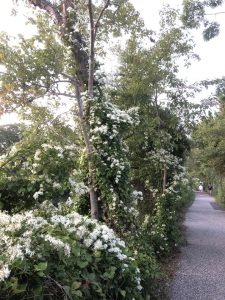Sweet Autumn?
How sweet it isn’t! Sweet Autumn or Japanese clematis is non-native and invasive— the darker side of beauty.

 Every year starting mid-August people ask me about the beautiful flowers draping the roadside trees. Twenty-plus years ago I misidentified it as Clematis virginiana or virgin’s bower, a native plant. A “bower” is a lady’s bedroom, and also refers to climbing plants in a garden or woodland. Another name is old man’s beard, for the white whiskers it drapes over the landscape.
Every year starting mid-August people ask me about the beautiful flowers draping the roadside trees. Twenty-plus years ago I misidentified it as Clematis virginiana or virgin’s bower, a native plant. A “bower” is a lady’s bedroom, and also refers to climbing plants in a garden or woodland. Another name is old man’s beard, for the white whiskers it drapes over the landscape.
But I had not taken time to examine the leaves. The blossoms seem identical and have fooled many people besides myself. In fact, many agricultural extensions and botanical gardens have written identification sheets because novices like me are easily fooled into misidentification.
The plant that I see on roadsides and along the rivers and streams is the more prolific non-native invasive species called Clematis terniflora or sweet autumn clematis. When I first noticed it on our property I thought, “What a lovely vine.” When I learned it was not native I gave it a hairy eyeball. For years I never saw it anywhere but on one site on my property along the river’s bank. Today, I see it on Silver Run Road along the edge of the Nature Conservancy’s Bluff Preserve and on the opposite side of the street. It makes a wall of white flowers that seem impenetrable. And for the past few years it shows up regularly in my once-native flower garden, now visited by many invasives. It is an aggressive player and a stand-out bad performer. Now mind you, not all the alien species in my yard were put there by birds, wind, or water. Unfortunately, like many homeowners I was lulled into purchasing non-native plants for a long time. Most people have yards filled with exotic plants. In the late 1800s landscapers began encouraging the use of this vine, especially on trellises. However, happily many people’s attitudes are shifting toward native flora.
 Before we get into the differences between this similar species let’s discuss why you would want to plant natives and avoid exotic species. Native plantings provide habitat, food, cover, and breeding areas for indigenous wildlife. Native insects have evolved as specialists on specific native plants on which they are dependent. Insects are the very foundation of most species’ existence, including people. Natives support pollinators that fertilize food sources for indigenous animals and people. They are an integral part of a diverse habitat community and help reverse species loss.
Before we get into the differences between this similar species let’s discuss why you would want to plant natives and avoid exotic species. Native plantings provide habitat, food, cover, and breeding areas for indigenous wildlife. Native insects have evolved as specialists on specific native plants on which they are dependent. Insects are the very foundation of most species’ existence, including people. Natives support pollinators that fertilize food sources for indigenous animals and people. They are an integral part of a diverse habitat community and help reverse species loss.
Native plants are more adaptive, and once established take little care. Exotic species are often invasive and out-compete native species that are essential for our region’s wildlife. Exotic species do not provide these values. Many provide nectar sources but if pollinators are expending energy on exotics they may be neglecting natives. And the plant is not likely providing all the support that pollinators need in their lifecycle. For instance, butterflies need a host plant, or plant that their larva feeds upon. Nectar plants alone will not ensure their survival.
Clematis terniflora, in addition to sweet autumn clematis, is also called Japanese clematis because it is native to Japan and China. It blankets native vegetation and eliminates the basic source that plants need to make energy—sunlight, smothering vegetation beneath it. It commonly overgrows saplings and small trees, killing some. It generally begins by invading road edges where there is light and waterways and where its seeds are easily transported.
It is a vine with a robust central root system. Pulling it out simply leaves the roots in the ground. And since it is perennial it will persist. Mature plants will extend often 30 feet high. A main stem can have a four-inch diameter; in our yard a pencil-size stem can support growth 20 feet high. Thankfully, its tendrils rarely root. If you have it in your yard I would strongly advise digging it up and disposing of it in the trash. We have been tearing it out before it goes to seed, but we know water, wind, and birds will keep it persistent.
 The leaves of terniflora are more smooth-edged and ovate to ovate-cordate shaped. It can be distinguished from its lookalike native Clematis virginiana, which has toothed leaves. Both have lovely white flowers; the difference is that terniflora is the darker side of beauty.
The leaves of terniflora are more smooth-edged and ovate to ovate-cordate shaped. It can be distinguished from its lookalike native Clematis virginiana, which has toothed leaves. Both have lovely white flowers; the difference is that terniflora is the darker side of beauty.
The plant invades from states that border the Mississippi to the Atlantic Ocean; the range extends into Canada and south to the Gulf of Mexico. Some maps show it to occur in California as well. Often an exotic plant will go years before it takes on truly invasive characteristics, but when it does, stopping it may be impossible. If you have ever seen a kudzu-infested area you have an idea how bad things can get. Everything can be blanketed—homes, barns, entire properties and forests.
Can you purchase it? Yes. Should you purchase it? Absolutely not. Some sellers will tell you all you have to do is cut off the flowers before they go to seed in order to control it. That is simply crazy. Why not purchase the native plant instead? And do you prune your vines at 30 feet tall? Do you always get all the flowers? The flowers are crazy prolific. It will escape cultivation, it has.
If you’re interested in native plants, CU Maurice River can recommend sources for great information. You will want to check out naturalist Pat Sutton’s website. We strongly suggest you join Pat’s Gardening Gang on the home page at patsuttonwildlifegarden.com. And membership is free. Once you get started, the butterflies, birds, and wildlife you attract will get you hooked on native plantings!








